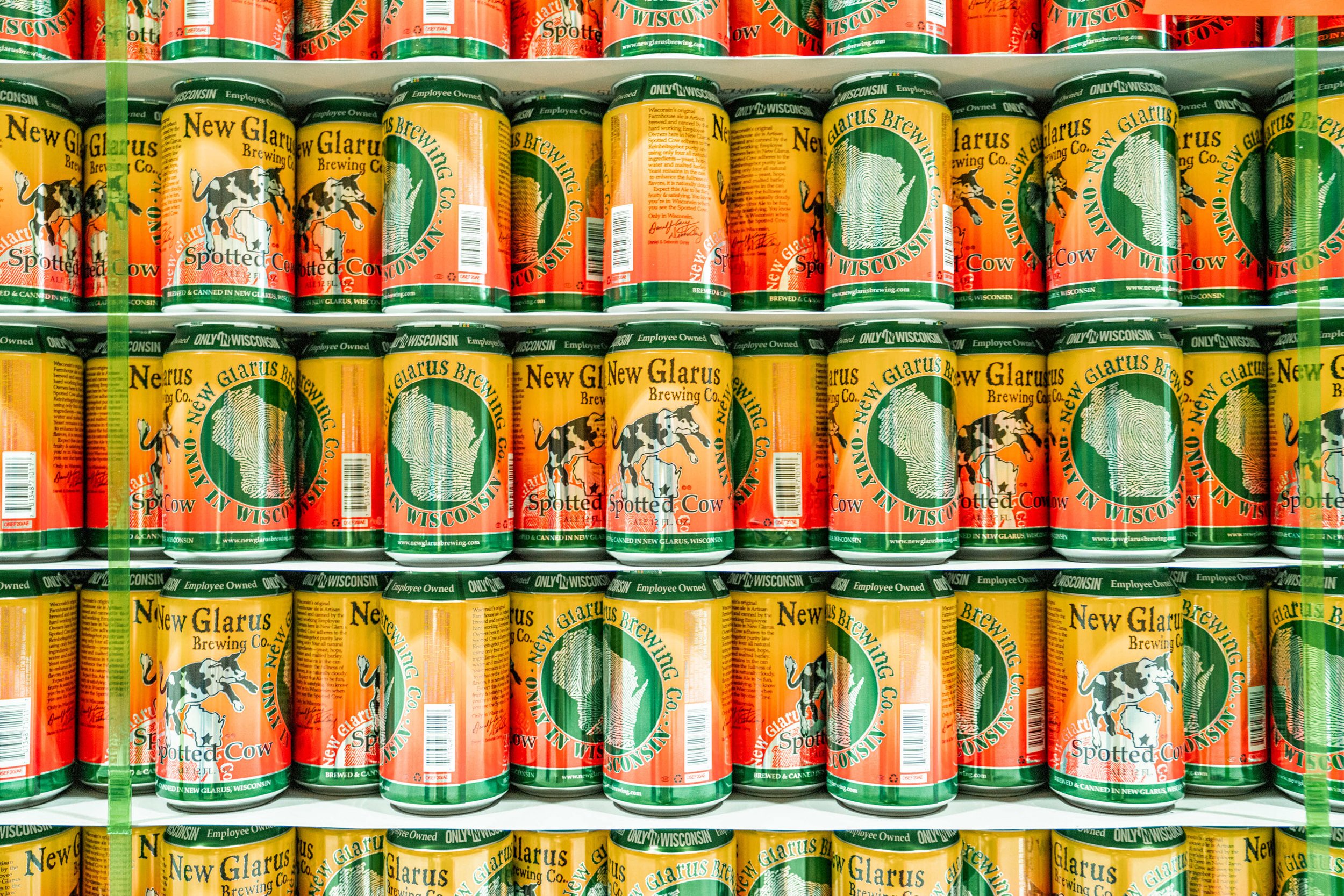Molly Scullin needed a “Scrubs” autograph, any “Scrubs” autograph. It’s what her coworker wanted in exchange for a weekend shift off work to attend her Park Falls, Wisconsin, family reunion. It was the sort of gathering anyone would go to strange lengths to attend—there would be a tap truck with Spotted Cow, the flagship beer of Wisconsin’s New Glarus Brewing Co.
Scullin forgot to get the autograph from her well-connected cousin. Realizing she was returning to Iowa empty-handed, she made an emergency stop in before-the-border Hazel Green and dreamt up a satisfactory bribe: a case of Spotted Cow. “It worked,” says Scullin. “My coworker completely forgot about the autograph.”
Anecdotes about Spotted Cow doubling as currency aren’t hard to find—nor are ones about “smuggling” the only-in-Wisconsin beer. When Leon Delgado was overnighted in Salt Lake City en route to California, he had to explain how his bag “might explode” if left on the plane. Once he clarified he was talking about cases of Spotted Cow, the prickly agent beamed.
But most tales of the easy-drinking, “Farm Cask conditioned ale” seem to evoke images of family, connection, and nostalgia. When Annie Louis moved to South Carolina, she’d flit back and forth with cases of the stuff to remind her of home. When Kara Daily goes to visit family in Iowa, she’s on Spotted Cow duty from Madison. When Katy Joyce got engaged, it was her “Champagne”—she grabs three cases every drive back to Omaha. And when Adam Osterhaus has family reunions, there’s always one main event but with two Wisconsin specialties: Curds and ‘Cow.
“Popular” doesn’t seem to cut it when describing this craft beer. To many of Wisconsin’s former and current residents, it’s a 12oz bottle of identity. How New Glarus' Spotted Cow won its status as an American icon involved a lot of rule-breaking, a dash of female intuition, and a bit of inexplicable luck.
When you drive into New Glarus, Wisconsin, on Hwy 69—from either direction—you’ll see a vintage chalet-style sign that reads “WELCOME TO NEW GLARUS, AMERICA’S LITTLE SWITZERLAND—HOME OF SPOTTED COW.”
“There was no agenda. It was just simply another idea. That’s all I do—think of ideas.”
Of course, it’s not just home to Spotted Cow—it’s home to all four walls of New Glarus Brewing Co., the makers of Spotted Cow, Moon Man, Two Women, and a dozen or so other beers at any given time. Deb Carey is the founder; entering the scene in 1993, she was one of the first women to found and operate a brewery in the United States. (Contemporary Carol Stoudt founded Stoudt Brewery in 1987; Irene Firmat founded Oregon’s Full Sail Brewing Company that same year.) Daniel Carey, her husband, is sometimes referred to as co-founder, but he clarifies to me quickly: “Deb’s the founder. I’m the brewmaster. Really, I’m First Employee.”
The beer that would skyrocket them to international fame has its roots in a casual trip to Old World Wisconsin. The couple wandered into the root cellar of the 1850s-era German homestead, says Dan Carey, where a crockpot covered with cheesecloth was fermenting beer. Naturally, the brewer wondered what was inside—what would farmers have brewed in those days? What would the beer have been like? He ruminated: It would have been an Ale, as Lager requires technology, ice, and time; it would have been unfiltered and therefore a bit hazy; and if the farmer had money, he would’ve used really good hops from the Czech Republic. At the time, it was just one of hundreds and hundreds of ideas the brewer had. “There was no agenda,” he says. “It was just simply another idea. That's all I do—think of ideas.”
Then, in 1996, the two were off to England to receive an award for their second-ever beer, a Belgian Red, when the lightning struck. In rural Yorkshire, Dan recalls, Deb kept saying, “Boy, all I see are lambs.” Quiet for a moment, she goes, “People must come to Green County and say, ‘Boy, what's the deal with all these spotted cows?’”
Bingo. Dan concocted the recipe (in almost 30 years the only change has been to the use of corn), Deb drew the label by hand, and the beer hit the shelves. And then the battle began.
Spotted Cow was a difficult sell initially, explains Dan. Wholesalers were vehemently not onboard. His eyes steel as he impersonates their dismissal: “Deb, no, we're guys. We can't go into a bar and sell a beer called Spotted Cow. That's nuts!”
The fact that it was Deb dealing with the wholesalers isn’t lost on Dan; asked point-blank if pushback had anything to do with misogyny, his answer is clear: 100%. “I stand next to her and I see it, watch it, observe it,” he says. It's not just men—women, too. “When people don't like the answer they're getting from Deb, she gets the classic, ‘Put your husband on the phone! I want to talk to the man in charge!’” I ask if she actually does hand over the phone in these moments. Dan laughs out his response: “Oh god, they don’t want to talk to me!”
Of course, Dan deals with his fair share of guff, too. He recalls a man marching into the brewery a decade ago and demanding that “beers should have names like Schlitz and Bud and Miller! What the hell is a Spotted Cow?!” By that time, he was seasoned and ready. “I appreciate your point,” he said, unwavering. “But what the hell is a Budweiser?”
The name, the presence of a woman—those were only the first sticking points. When the Careys started the brewery in 1993, craft beer in Wisconsin meant only one thing: Amber Lager.
“When you went into a tavern in Wisconsin,” Dan Carey explains, “you had Miller Light and Zima or whatever, and then you had Capital or Sprecher Amber.” That was the entirety of the Wisconsin craft beer scene, Dan Carey says, and he had no interest in reinventing the wheel or fitting the mold—he wanted to brew something he would drink.
And what he would drink was too complex for the light beer drinkers and too simple for the beer geeks, Dan reckons, describing the Farmhouse Ale as decidedly “not flashy,” “not the cool-kid beer,” “just sort of existing between worlds.” So there Spotted Cow sat, just another beer from another craft brewery that wasn’t honoring Wisconsin’s Lager-filled past. It took between six and eight years before the brewery’s staff noticed rows of Spotted Cow moving faster and faster. And faster.
“You know the saying,” he says. “It takes many, many years to be an overnight success.”
“It’s by far our most popular beer since the day we opened 17 years ago,” says Jennifer De Bolt, general manager of The Old Fashioned in Madison, Wisconsin. The popular tavern-style restaurant on Capitol Square sells 122 Wisconsin beers—50 on tap and 72 in bottles—yet Spotted Cow makes up 61% of total beer sales. Arguably Madison’s most recognized restaurant, it specializes in (and is named for) the well-known cocktail, Wisconsin’s other classic libation, and yet it averages nearly 500 pints of Spotted Cow every six-day week.
Businesses all across the state rake in the profits from being associated with the sudsy bovine—gas station windows advertise the beer around every corner; liquor stores on the border know their bread and butter; grocery stores like Woodman’s in Kenosha advertise “the world’s largest display of New Glarus beers” (2,646 cases). The majority of which is, of course, Spotted Cow.
Similarly, the Ale makes up roughly 75% of the brewery’s production, or 175,000 barrels, a percentage that increases by the year. New Glarus is a top-15 craft brewery, as defined by trade organization the Brewers Association, but Spotted Cow alone would fall just a few spots behind it. It’s an amazing feat for a brewery that technically doesn’t sell a drop outside the borders of Wisconsin. (Some enterprising souls may take it elsewhere to sell, which is illegal, but the company can’t control that.)
“It’s by far our most popular beer since the day we opened 17 years ago.”
And while the beer’s popularity can seem lucky or accidental or even ironic—considering its initial reception—Dan Carey clarifies that the beer is what Deb Carey imagined it to be: a quintessentially Wisconsin beer that fits the quintessential Wisconsin sensibility.
Go to San Diego, he argues, where people speak quickly, move quickly, and think as they talk; the fact that the City in Motion is a hub for assertively bitter, dry beers is a natural reflection of its culture. Wisconsin, on the other hand, is more “shorts and sweatshirts and relaxing.” Parochial and proud, the Dairy State was—eventually—won over by a hand-drawn Friesian cow, a hazy Ale fit for evening football games.
At least, most of the Dairy State. Milwaukee’s Romans’ Pub, which for years has been among many lists sharing “the best places to drink beer in America,” refused to sell the beer. The pub—temporarily closed this summer after owner Mike Romans’ death—had a decade-old sign that read “No Spotted Cow. Not now. Not ever.” Known for a gruff-yet-loving attitude, Romans himself once called Spotted Cow a “training-wheels beer.”
And maybe it is, but then Wisconsin’s on one giant kiddie ride. Dan knows it’s easy drinking, and that’s part of the point. Spotted Cow is intended for Fourth of July picnics, summertime at the lake, or cheering on the University of Wisconsin Badgers—it’s a communal beer. The team argues about whether it hits with notes of peach or apricot, but they all agree on its little bit of snap and sweetness with just enough hoppy bitterness to keep the beer from lingering.
“To me—and I can’t explain it,” I tell Dan Carey, “it tastes like a patio.”
“Yeah.”
Spotted Cow was available in Illinois until 2003, when the Careys decided to pull distribution from outside Wisconsin. The seven-person sales team struggled to keep pace with demand, but more importantly, “bigger” was simply never the goal. At roughly 230,000 barrels a year, they’re already the 12th-largest craft brewery in the nation by sales volume. And thanks to factors like supply chains and sustainability, that decision is proving all the wiser.
Dan Carey says the beer’s only-in-Wisconsin nature—advertised on the case in big block letters—has little to do with its popularity. When a local distiller accused him of benefitting from the scarcity principle, where lack of availability increases demand, Dan asked the distiller if he was planning on limiting distribution. No, the distiller replied, and Dan pulled no punches: “Then either put your money where your mouth is, or you’re full of beans. Which is it?”
If the beer’s scarcity hasn’t increased its appeal, it’s certainly increased its notoriety. Every few years, another headline reads: “Spotted Cow Sold Illegally Across State Lines.” In 2009, a Manhattan bar got busted for selling Spotted Cow during Badger games (for $7/bottle); in 2016, a Minnesota bar was busted for putting the beer on tap; Cubs fans were caught smuggling kegs and reselling them in Chicagoland in 2021.
Google “Spotted Cow,” and the second prompt is, “Why is Spotted Cow illegal?”
Ultimately, Dan thinks the beer’s incredible popularity boils down to the fact that it fits an underserved niche: a beer that’s easy drinking yet complex. The American Light Lager, he says, is elegant in its simplicity, but it's boring. Spotted Cow manages to retain that drinkability without sacrificing experience. When you drink a really good beer, that’s what every sip should be: an experience.
“It’s that marriage of complexity with drinkability. It’s that holy grail.”
“It's like reading a good book,” he adds. “When you have a good book and you turn the page, you're like, wow. It’s that marriage of complexity with drinkability. It’s that holy grail.”
I point out to Dan Carey that all this—the taste, the name, the woman, the distribution—flew in the face of standard operating procedure. That, time and again, they refused to heed the unwritten rules. When people told Deb Carey to sit down, to go national, to brew Amber Lager, to change the name, they never did.
“That’s 100% true,” says Dan.
That’s the most detail he’ll give me. Pressing him on how they managed to stay to their own path—and where they learned that principle in the first place—he credits Deb and Deb alone.
“It’s Deb. She has vision. She can see things around the bend,” Dan explains. “When the bolts start to fly and most people would panic, she sees.”
























